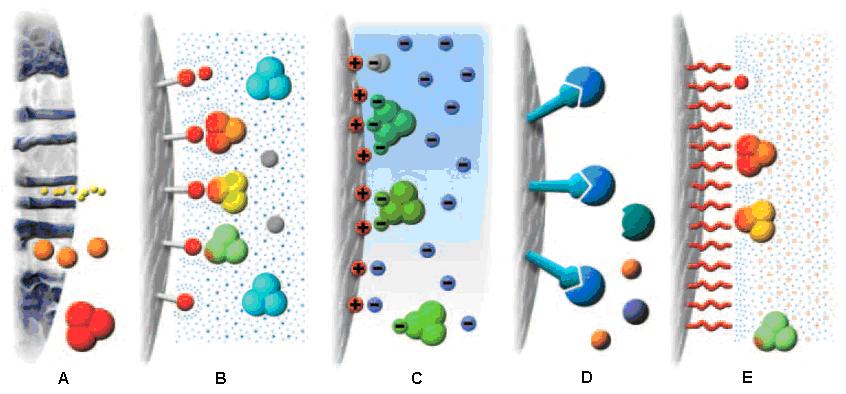|
Protein Separation Technique
In proteomics, the tasks of generating and testing a large number of variants of a molecule and of optimizing expression conditions
for one distinct molecule create the need for separation and purification methods that can handle a large number of samples
simultaneously. (Gottstein and Forde, 2002)
Biomolecules are purified using purification techniques that separate according to differences in specific properties,
as shown in figure below. (Amersham Biosciences, 2008)
 |
 |
|
Property
|
Technique
|
|
Biorecognition (ligand specificity)
|
(D) Affinity chromatography
|
|
Charge
|
(C) Ion exchange chromatography
|
|
Size
|
(A) Gel filtration/size exclusion
|
|
Hydrophobicity
|
(B) Hydrophobic interaction chromatography
(E) Reversed phase chromatography
|
|
 |
 |

|
|
Background Information
A major goal in the biochemistry or molecular biology laboratory is the isolation of a specific protein from complex mixtures.
Such isolation procedures often involve several fractionation steps with the effectiveness of each step monitored by electrophoresis.
Chromatography is a type of fractionation similar to electrophoresis in that proteins separate from each other as they are
passed through a matrix. With chromatography, however, solvent flow (by gravity, pressure or capillary action), not an electric
field, carries the proteins through the matrix. The separation occurs because proteins interact with various matrices in different
ways. Chromatography matrices are designed to exploit the physical and chemical interactions of a protein of interest. For
example, acidic proteins will interact with a basic matrix to a greater extent than basic or neutral proteins so a basic matrix
can be used to separate acidic proteins (which will interact with the matrix and be retained) from non-acidic proteins (which
will flow through the matrix). The acidic proteins retained by the matrix can then be removed or eluted by disrupting their
interactions with the matrix. The major limitation of most types of chromatography is the lack of specificity for only one
protein, for example a basic matrix will retain all acidic proteins to various extents and not just the specific protein of
interest.
Affinity chromatography is a method that overcomes this limitation by exploiting the unique interaction of one molecule
with a second, complementary binding molecule (ligand). It is one of the most useful and effective fractionations that can
be applied and often proteins can be purified in single affinity chromatography step. Affinity chromatography applications
are not limited to protein purification and some general types of molecules which have been isolated by affinity chromatography.
|


